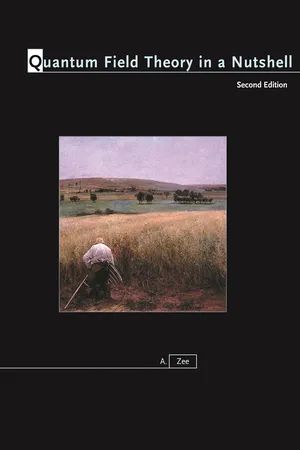
- 608 pages
- English
- ePUB (mobile friendly)
- Available on iOS & Android
About this book
A fully updated edition of the classic text by acclaimed physicist A. Zee
Since it was first published, Quantum Field Theory in a Nutshell has quickly established itself as the most accessible and comprehensive introduction to this profound and deeply fascinating area of theoretical physics. Now in this fully revised and expanded edition, A. Zee covers the latest advances while providing a solid conceptual foundation for students to build on, making this the most up-to-date and modern textbook on quantum field theory available.
This expanded edition features several additional chapters, as well as an entirely new section describing recent developments in quantum field theory such as gravitational waves, the helicity spinor formalism, on-shell gluon scattering, recursion relations for amplitudes with complex momenta, and the hidden connection between Yang-Mills theory and Einstein gravity. Zee also provides added exercises, explanations, and examples, as well as detailed appendices, solutions to selected exercises, and suggestions for further reading.
- The most accessible and comprehensive introductory textbook available
- Features a fully revised, updated, and expanded text
- Covers the latest exciting advances in the field
- Includes new exercises
- Offers a one-of-a-kind resource for students and researchers
Leading universities that have adopted this book include:
- Arizona State University
- Boston University
- Brandeis University
- Brown University
- California Institute of Technology
- Carnegie Mellon
- College of William & Mary
- Cornell
- Harvard University
- Massachusetts Institute of Technology
- Northwestern University
- Ohio State University
- Princeton University
- Purdue University - Main Campus
- Rensselaer Polytechnic Institute
- Rutgers University - New Brunswick
- Stanford University
- University of California - Berkeley
- University of Central Florida
- University of Chicago
- University of Michigan
- University of Montreal
- University of Notre Dame
- Vanderbilt University
- Virginia Tech University
Frequently asked questions
- Essential is ideal for learners and professionals who enjoy exploring a wide range of subjects. Access the Essential Library with 800,000+ trusted titles and best-sellers across business, personal growth, and the humanities. Includes unlimited reading time and Standard Read Aloud voice.
- Complete: Perfect for advanced learners and researchers needing full, unrestricted access. Unlock 1.4M+ books across hundreds of subjects, including academic and specialized titles. The Complete Plan also includes advanced features like Premium Read Aloud and Research Assistant.
Please note we cannot support devices running on iOS 13 and Android 7 or earlier. Learn more about using the app.
Information
I.1 Who Needs It?
Who needs quantum field theory?


Table of contents
- Cover
- Half title
- Title
- Copyright
- Dedication
- Contents
- Preface to the First Edition
- Preface to the Second Edition
- Convention, Notation, and Units
- Part I: Motivation and Foundation
- Part II: Dirac and the Spinor
- Part III: Renormalization and Gauge Invariance
- Part IV: Symmetry and Symmetry Breaking
- Part V: Field Theory and Collective Phenomena
- Part VI: Field Theory and Condensed Matter
- Part VII: Grand Unification
- Part VIII: Gravity and Beyond
- Closing Words
- Part N
- More Closing Words
- Appendix A: Gaussian Integration and the Central Identity of Quantum Field Theory
- Appendix B: A Brief Review of Group Theory
- Appendix C: Feynman Rules
- Appendix D: Various Identities and Feynman Integrals
- Appendix E: Dotted and Undotted Indices and the Majorana Spinor
- Solutions to Selected Exercises
- Further Reading
- Index